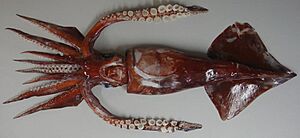Antarctic flying squid facts for kids
Quick facts for kids Antarctic flying squid |
|
|---|---|
 |
|
| Conservation status | |
| Scientific classification |
The Antarctic flying squid (Todarodes filippovae) is a type of squid. It belongs to a group of squids called Ommastrephidae, which are known as "flying squids" because some can leap out of the water! This squid lives in the seas around the southern parts of the world, especially in the Southern Ocean.
Contents
What Does the Antarctic Flying Squid Look Like?
The Antarctic flying squid is a large ocean squid. Females can grow to be over 52 centimeters (about 20 inches) long, and males up to 40 centimeters (about 16 inches). That's pretty big for a squid!
Its body, called the mantle, is long, narrow, and strong. It tapers down to a pointed tail. The fins on its body are shaped like arrowheads. They are about half the length and width of the main body.
The squid has strong tentacles and arms. The suckers on its arms have about 10 teeth. One of its right arms is special; it's used for mating. This part of the arm has suckers that have changed into small bumps. The large tentacles have clubs with many rows of suckers. The biggest suckers have 7-13 teeth on their rings.
Where Do Antarctic Flying Squids Live?
You can find the Antarctic flying squid all around the Southern Ocean. This is the ocean that surrounds Antarctica, south of 35°S latitude. They are quite common in the area where warm and cold waters meet, known as the subtropical convergence zone. Sometimes, they are found further north, like near Peru. Scientists think these squids might have drifted there on ocean currents.
How Do Antarctic Flying Squids Live?
These squids live in both coastal areas and the open ocean. They can be found anywhere from the surface down to depths of 1,200 meters (about 4,000 feet). They like fast ocean currents. They can also live in a wide range of temperatures, from very cold Antarctic waters (around 3-3.6°C) to warmer waters (up to 24°C).
Reproduction and Growth
Antarctic flying squids usually lay their eggs between December and August. Males are ready to reproduce when their bodies are about 26 centimeters long. Females can lay eggs when they reach about 38 centimeters. Studies show that they might reproduce in warmer northern areas of their range.
Like most flying squids, they grow very quickly. Their whole life cycle is usually completed in just one year. Females tend to grow faster than males. Interestingly, these squids grow faster in cooler water than they do in warmer temperatures.
What Do They Eat?
Antarctic flying squids are predators. They eat fish, crustaceans (like crabs and shrimp), and other squids. Smaller squids mostly eat crustaceans. But once they grow larger than 20 centimeters, they mainly hunt other squids.
Who Eats Them?
Many animals prey on the Antarctic flying squid. These include different types of fish, seabirds, and marine mammals. Even very large animals like sperm whales eat them! Adult squids sometimes have small creatures called parasites living on them.
Are They Fished?
People have fished for Antarctic flying squids in places like the Falkland Islands and the Tasman Sea. Today, they are often caught by accident when fishermen are trying to catch other types of fish. Because there are many of them and they have strong meat, scientists think they could be a good species for commercial fishing in the future.
See Also
- Todarodes


